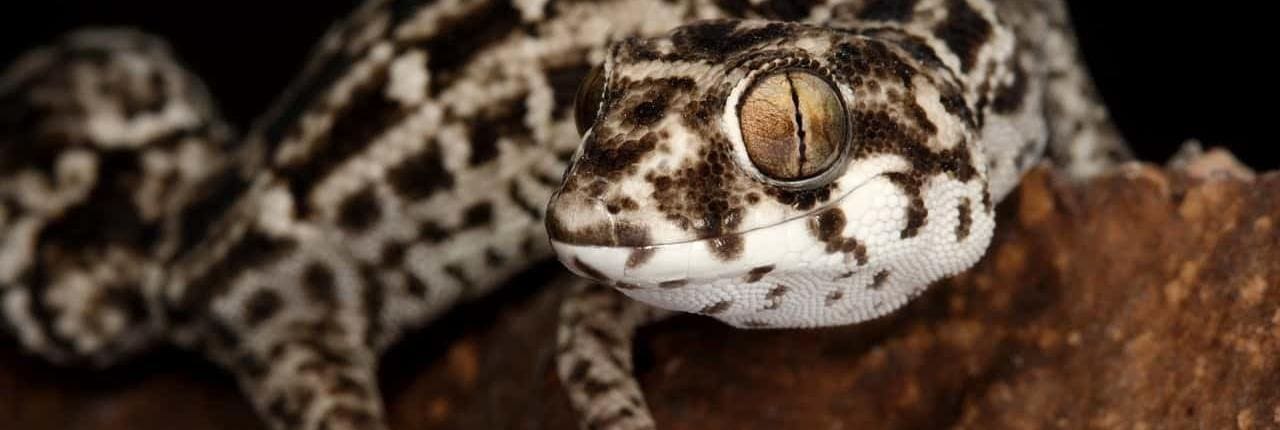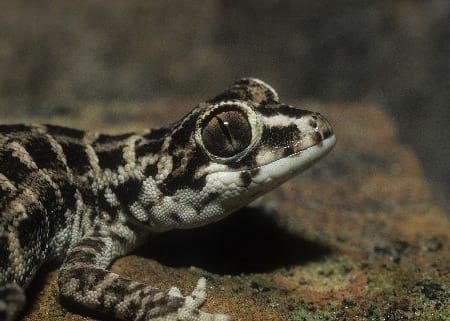Viper Gecko Information:
Before purchasing your new pet viper gecko for sale, be sure to find a reputable captive bred viper gecko breeder (like us!) and do your research so you can enjoy your new pet viper gecko for sale for years to come by providing proper viper gecko care.
Viper Gecko NATIVE REGION
Viper geckos for sale are becoming very popular as they can make fantastic pet geckos. Viper geckos, also called carrot tail geckos, (not to be confused with the carrot tail Leopard Gecko) are a small, terrestrial species found in Pakistan. Most of these geckos will grow to be 3-4 inches at maturity. In their natural environment, these geckos are often found hiding beneath rocks and in rock crevices. Their general coloration is a dark brown, with gray and white bands running up and down their body. They are also prone to light gray speckling.
Viper Geckos TEMPERATURE – HUMIDITY
Viper geckos should have a hot spot of 85-95 F during the day. Their nighttime temperatures can fall to 75 F. As with all reptiles, you should always provide a temperature gradient. Always remember with any heating device, light, tape, or commercial heater, — USE A THERMOSTAT AND MONITOR WITH A THERMOMETER! DO NOT GUESS! DO NOT — USE HEAT ROCKS! With them being from the desert, they do not need any humidity.
Viper Gecko LIGHTING
Viper geckos do not require UV lighting. However, like all reptiles, you do need to create a proper photoperiod. During the summer you should offer your viper gecko a day light cycle of 14 hours on, with 10 hours off to make up the night cycle. As winter approaches, you should change their photoperiod so that they end up with 10 hours of light with 14 hours of darkness. To make the change more natural and gradual, you could begin by changing the day cycle to 13 hours with a night cycle of 11 for 2 weeks. This is best started in the fall months. Then you could offer both the day and night cycle of 12 hours for another week. The next week could then be followed by an 11 hour day cycle, with a 13 hour night cycle and for the remainder of the winter, offer the 10 hours of night and 14 hours of darkness. As spring approaches, simply reverse the gradual changes so that the day cycle increases and the night cycle decreases.
This would help create a more natural approach to the changing of the seasons.
Viper Gecko HOUSING
Viper geckos do no not require large enclosures for housing. (Bigger IS always better and more natural. They are not confined in the wild to a 10 gallon enclosure.) Due to their size, Viper geckos can be adequately housed in a shoe box tote (12 qt) with a screen lid or a 10 gallon tank.
These geckos can be housed in pairs of one female and one male or multiple females to one male. Never keep two males together.
You should provide ample hiding places for your vipers. The hides should be placed on each end of the enclosure. (If you created a proper heat gradient, this will allow the vipers to choose the end they require for proper thermo-regulation.) Hides can include half clay pots, cork bark, and commercial hides. Plant pot bottoms make great low lying hides.
To give your vipers something to climb and play on, you can use some larger rocks or bust a clay pot, and scatter that around the enclosure. If you use larger rocks, make sure they are secure. You don’t want anything capable of falling on your gecko.
If you have a gravid female, you should include a small box of moistened sand as a laying box.
Viper Gecko SUBSTRATE
You can keep them on paper towel, play sand, or coconut fibers. Sand is more appealing to the eye, but paper towel lowers the chance of impaction.
Viper Geck DIET
Viper geckos are insectivores. Crickets, waxworms, mealworms, small beetles, and fruit flies make up the bulk of their captive diet. Their staple food should be Crickets, and should be dusted every 3-4 days with Calcium & Vitamin supplements for adults and every 1-2 days for hatchlings. (Over supplementing any reptile can lead to illness such as hypercalcemia and vitaminosis.) As with many lizards, the prey size is depicted by the width of the space between their eyes.
An additional small dish of Calcium should be provided at all times. Supplements such as Herptivite and repcal calcium with D3 are adequate.
Viper Gecko SEXING
Sexing a Viper gecko is easier than one would think. The males will form large hemipenal bulges at the base of their tail, making them easy to distinguish from the females. You can generally sex them at 3-4 months of age. The older the gecko is, the easier they will be to sex.
Viper Gecko BREEDING
Viper geckos sexually mature at 10-12 months. Males mature faster than females do, and can be ready to breed at 7 months. The female will lay a pair of eggs, pea sized, in the moist hide you provided. They continue to lay a pair of eggs every 2-4 weeks for 8 months.
Once the eggs are located you should place them in an incubator at 83-86F with 50-60% humidity for 40-55 days. CBReptile.com is proud to offer the finest geckos for sale online of any online reptile breeder. We are a gecko breeder of many species and are well known for being a leopard gecko breeder, gargoyle gecko breeder and crested gecko breeder. Recently we started working with chaouho gecko for sale and viper geckos for sale and are now viper gecko breeders as well as a chahoua gecko breeder


